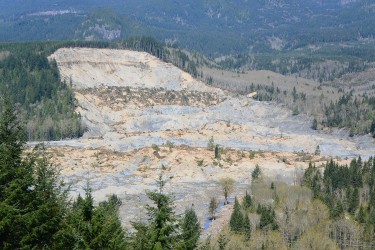 On Tuesday, October 13, the Department of Earth and Space Sciences‘ David Montgomery presented on disasters fast and slow as part of the Surviving Disasters: Natural Hazards & Resilient Communities speaker series.
On Tuesday, October 13, the Department of Earth and Space Sciences‘ David Montgomery presented on disasters fast and slow as part of the Surviving Disasters: Natural Hazards & Resilient Communities speaker series.
Co-sponsored by the College of the Environment, UW Alumni Association, and UW Graduate School, Montgomery highlighted the types of mega-hazards that leave entire communities in shambles and garner attention around the globe. These “fast” events happen in the blink of an eye. Less frequently discussed, Montgomery’s talk also covered “slow” hazard events. For example, the degradation of our soils over time—which will spell trouble for agriculture and societies that depend on it. In sort, everyone. It’s hard to start a conversation about something people can’t necessarily see, but he contends that it’s necessary.
Montgomery painted a compelling vision of how we can better use science to inform our decision-making, and reduce our risk for being impacted by a catastrophe. Currently, science plays a minor role in thinking about how we conserve our soils, site our buildings and communities, and protect ourselves from the natural hazards that surround us in an ever-changing world.
Key takeaways
- Risks are not adequately understood by people.
- We often do not use the science we have in service of policy.
- We’re getting better, though, through wider usage and funding for LiDAR.
- We’ve lost about a third of all cropland soil since World War II.
- Conservation agriculture involves (1) the direct planing of seeds, (2) permanent ground cover, and (3) diverse crop rotation to maintain soil fertility and break up pathogen carryover.
- For fast disasters, we need to recognize and avoid the hazards, get the science right, and then communicate it.
- For slow disasters, we need to adjust current practices to address their causes.
Quotes that resonate
- “One of the challenges we have in disaster management or planning and risk reduction is actually using the science we have at our disposal.”
- “LIDAR gives geologists the ability to see terrain with brand new glasses.”
- “We think there were two stages to this landslide; and that the ancient landslide surface probably helped serve as the failure plane for stage one and then this other material—that had not failed before—failed in its wake. In other words, this mobilization of this ancient landslide debris actually triggered an instability on material that had not failed before. This landslide grew and grew dramatically.”
Related reading
- When Nature Strikes – Science of Natural Hazards: Landslides (National Science Foundation)
- How to Make Landslides Less Deadly (The New York Times)
- Washington state mudslide conditions present ‘nightmare scenario’ for rescue team, says geologist (PBS NewsHour)
- UW geologist, engineer reflect back one year later on nation’s deadliest landslide (UW News)
- America is running out of soil (The Week)
- What Makes A Genius in Seattle? (KUOW)
Upcoming Surviving Disaster lectures
10/20: Jed Horne (RSVP) | 10/27: Kate Starbird (RSVP) | 11/3: Jake Wood (RSVP) | 11/10: John Vidale (SOLD OUT)

